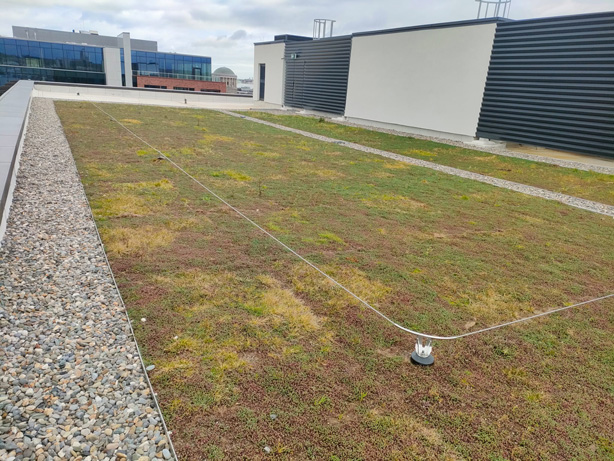As concerns about climate change grow, green roofs are also growing in popularity, especially in densely populated urban areas. Green roofs enhance biodiversity, improve insulation, reduce rainwater run-off, make buildings more attractive and provide amenities for residents who may not have access to private gardens.
The term ‘green roof’ refers to a roof that is partially or completely covered with vegetation and a growing medium, planted over a waterproof membrane. It may include additional elements such as root barriers, drainage or irrigation systems. Other features that can form green roofs include ‘container gardens’ where plants are maintained in pots, rooftop ponds and elevated open space areas that primarily form pedestrian routes on the roofs of lower level buildings.
The concept of green roofs has been around for several years, with the first green roofs appearing in northern Europe. Countries such as Scandinavia, Germany, Austria and Switzerland have a long tradition of using green roofs.
In some countries, legislation has been actually been introduced to encourage the installation of green roofs, with many German cities for example providing incentives for green roof installation. Around 10% of all German roofs are now green and in France a law has been passed dictating that rooftops on new buildings built in commercial zones must either be partially covered in plants or solar panels. Outside Europe, Canada, USA, Japan and Singapore have all experienced significant growth in green roofs.
In American cities such as Washington DC, Chicago, Philadelphia and New York City, financial incentives have been offered for installing green roofs. Closer to home, there is now an array of planning policies and environmental agendas pushing for green elements to be included in new build projects in particular.
In the UK, green roofs are most popular in the City of London. According to Footprint Magazine, there are now more than 1.5 million square metres of green roofs across London. Within densely built-up areas such as London, it is important that buildings are environmentally sustainable. With the close proximity of the River Thames, the abatement of flood risk is also a significant issue. Green roofs in the City of London minimise the urban heat island effect, whilst also providing rainwater run-off attenuation and reducing the risk of flooding.
Whether intensive or extensive, biodiverse or brown, it is critical that green roofs are built on a solid waterproofing foundation. Offering exceptional durability and outstanding green credentials, mastic asphalt is an ideal choice for specifiers seeking an eco-friendly waterproofing solution for green roof specifications.
Recognised for its environmental performance and aesthetic properties, a green roof system laid with a mastic asphalt waterproofing system enhances the environment, controls storm water run-off and reduces noise and heat transmissions by upgrading the acoustic and thermal performance of a roof. When contractors use mastic asphalt for a green roof system, it also eliminates the need for root barriers, which may well have been necessary had a substitute material been used.
The fact that mastic asphalt is being widely recognised as an effective green roofing solution was evident at the Mastic Asphalt Council (MAC) Awards 2023. The winner of the Development and Hybrid Project of the Year was John Fetherston Roofing for the green roofing installation completed at the Haymarket project in Dublin.
 The Smithfield district of Dublin is being regenerated and John Fetherston Roofing completed the Haymarket project as part of the regeneration works. Several IKO mastic asphalt systems were specified for various roof areas. The main roof comprised a 1,400m2 installation of IKO’s Permaphalt mastic asphalt system, and there was also a section where an IKO Extensive Green Roof was installed. With a shallow soil layer supporting moss and grass, the green roof system was chosen to enhance the client’s sustainability credentials
The Smithfield district of Dublin is being regenerated and John Fetherston Roofing completed the Haymarket project as part of the regeneration works. Several IKO mastic asphalt systems were specified for various roof areas. The main roof comprised a 1,400m2 installation of IKO’s Permaphalt mastic asphalt system, and there was also a section where an IKO Extensive Green Roof was installed. With a shallow soil layer supporting moss and grass, the green roof system was chosen to enhance the client’s sustainability credentials
The Mastic Asphalt Council (MAC) is an associate member of the Green Roof Organisation (GRO), an independent trade association dedicated to supporting and developing the green roofing industry in the UK.
The Green Roof Organisation represents all elements of the green roof sector including manufacturers of waterproofing and green roofing products, suppliers of green roof systems and components, specialist contractors from the roofing and landscape sectors and associates including other trade associations, designers and architects.
The vision of the Green Roof Organisation is for every city and town in the UK to require high quality green roofs on new build flat roofs – whether for amenity, biodiversity gain, rainfall management or aesthetics. Another aim is to drive the retrofitting of green roofs to existing buildings where structurally possible.
When contractors use mastic asphalt for a green roof system, it eliminates the need for root barriers, which may well have been necessary had a substitute material been used. Alternative membranes to mastic asphalt can also be more prone to site damage leading to potentially catastrophic and expensive leaks. Mastic asphalt also offers a safe, flame-free application.
Mastic asphalt has one further advantage over other types of waterproof membrane – it is carbon neutral – a massive bonus for any building owner anxious to show their green credentials. In addition, once it has reached the end of its useful life, mastic asphalt can be recycled or used as roof screed, minimising the impact on the environment. Several years ago the mastic asphalt sector became the first industry in the world to achieve the CarbonZero standard.
With the future of roofing looking green, the reliability and integrity of mastic asphalt has seen more and more architects and designers specifying this waterproofing membrane for a wide range of green roof applications – from schools to hospitals, office buildings to apartment blocks – making it their preferred choice for biodiverse habits that will indeed benefit us all both now and in the future.
The MAC Awards 2024 are being hosted on Friday 7th June 2024 at the Royal Horseguards Hotel in London. With thanks to the sponsors for this year’s event, namely headline sponsor SIG, BriggsAmasco who are sponsoring the Apprentice Award, W J Horrod who are sponsoring the guest speaker, IKO who are sponsors of the pre-dinner event and John Fetherston Roofing who are sponsoring the lunch table drinks.
This article featured within the February 2024 edition of RCi magazine – click here to view the article.

